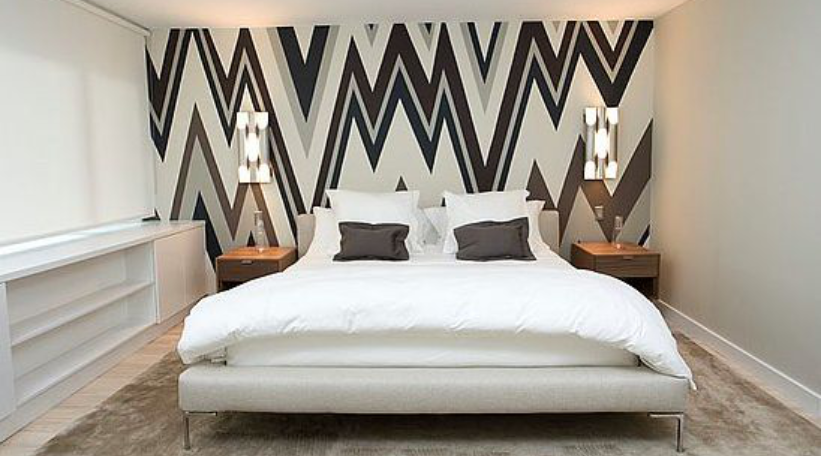Accent walls are popular, and they aren’t the domain of paint alone
By Tammy Adamson-McMullen
Accent walls are a beautiful way to add color, drama and even a perception of size to a room. Paint traditionally has been the medium of choice for accent walls, which usually are painted in a complementary or contrasting color from the rest of the walls in a space. But wallpaper is gaining momentum on accent walls because they offer the additional benefits of pattern and texture. Pay attention this spring, and you’re likely to see wallpapered accent walls in a variety of places, from residential dwellings to restaurants, offices and other commercial spaces.
If the idea of a wallpapered accent wall appeals to you, spend some time in your local paint and decorating store to find the right pattern—meaning, the right colorway, pattern size, and image—for your space.
What is a good location for a wallpapered accent wall? Below are a few ideas, but one word of caution: Don’t overdo it. An accent wall is fine here and there, but you wouldn’t want one in every room.
- Bedrooms. Bedrooms are ideal for a wallpapered accent wall. Choose a wallpaper that complements your existing décor and in a pattern that brings a feeling of calm and relaxation. Nature-inspired themes and textures are spot-on for this purpose, such as botanicals, sea-inspired images, murals of forests or mountain meadows, grasscloth textures and so on. Any bedroom wall can be used as an accent, but the wall behind the headboard tends to be perfect.
- Home Offices. Similarly, home offices also need to have a sense of calm, but they should enhance focus. To avoid being distracted as you work, choose a wallpaper with little or no pattern. Opt instead for a textured wallpaper in a soothing colorway, such as sage green, terracotta red, dusty blue or sandy beige. Metallic wallpapers also can work, but matte finishes are best (less distracting).
- Living Rooms. A wallpapered accent wall can add some “life” to your living room. This is an ideal place to go use larger-scale images since the furniture in living rooms also tends to be larger scale. Of course, the wall behind the sofa is always a safe bet for an accent wall, but you also might consider papering a wall near a favorite chair, behind a piano, next to a wall of shelves or in a cozy sitting nook.
- Staircases. Let’s face it: Most staircases are, well, boring. To liven up this often neglected area of the home, try putting an accent wall at the top of the stairs or under the stairwell. Make sure the wallpaper flows with the style and colors of the rest of the home, especially if your staircase is visually open to other rooms. But don’t be afraid to be a bit bold. Bolder colors and patterns can work well in areas that have architectural detailing.
- Playrooms. Whimsical wallpapers make excellent accent walls in children’s playrooms and bedrooms and help to enhance their imaginations. Many wallcovering manufacturers offer children’s wallpapers and murals, so there are plenty of patterns from which to choose—some of them licensed from children’s books and movies. Opt for large-scale images that heighten children’s sense of play. And be sure to include your child in the selection. (Note: One benefit of installing a wallpaper accent wall in a playroom, rather than throughout the entire room, is that there is less wallpaper to remove later as children grow and their tastes change.)
- Kitchens. Kitchen accent walls may be the most fun to create because you can inject so much creativity into them. There are plenty of kitchen wallpapers out there, from charming patterns that invoke European cafes and American diners to delicious images of harvested fruits and vegetables to elegant geometric and abstract patterns. If you have a dining nook in your kitchen, consider putting your accent wall there to help define the space.
- Formal Dining Rooms. Many homes still have dining rooms—although open floor plans are chipping away at this traditional space. If you do have a dining room, chances are it’s highly visible to other areas in your home. Depending on your style, you may want to choose a more formal pattern than you would for a kitchen accent wall. Traditional patterns—such as fleur delis, botanicals, plaids, and stripes—are good choices for dining rooms and are being reimagined in new ways to work with more contemporary decors.

 Interior Paints
Interior Paints Exterior Paints
Exterior Paints Primers
Primers Stains & Clears
Stains & Clears
 Paint Brushes
Paint Brushes Paint Roller
Paint Roller Paint Trays & Liners
Paint Trays & Liners



